This article has multiple issues. Please help improve it or discuss these issues on the talk page . (Learn how and when to remove these template messages)
|
Sonicare is the brand name of an electric toothbrush produced by Philips.
This article has multiple issues. Please help improve it or discuss these issues on the talk page . (Learn how and when to remove these template messages)
|
Sonicare is the brand name of an electric toothbrush produced by Philips.
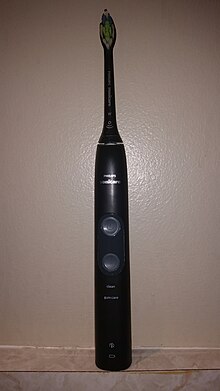
The brush head vibrates at hundreds of times per second, with the latest models at 31,000 strokes per minute (517 Hz) or 62,000 movements per minute [1] (1033 Hz). Rather than connecting to its charger with conductors, it uses inductive charging —the charger includes the primary winding of the voltage-reducing transformer and the handle of the brush includes the secondary winding. The replaceable head is also driven magnetically. Currently, there are multiple types of Sonicare brushes.
Individual clinical research has shown Sonicare toothbrushes to be more effective than comparable Oral-B electric toothbrushes in reduction of gingival inflammation and therefore improvement in periodontal health. [2] However a 2004 review of 29 studies concluded that only electric toothbrushes with rotational/oscillation movement removed more plaque than other brushes when correctly used. [3] A second review found no clinical evidence for the dynamic fluid activity of the Sonicare toothbrush being more effective in plaque removal than an Oral-B oscillating/rotating electric toothbrush. [4] A 2007 study comparing the two found the rotation/oscillation brush to be more effective in single-use plaque reduction. [5]
An additional study showed that while both Sonicare and Oral B electric toothbrushes do better than manual toothbrushes in removing plaque, reducing gingival inflammation, and reducing probing depths, the Sonicare showed significantly more improvement than Oral B. The percentage reduction in inflammation from baseline at 6 months was 31.9% for Sonicare and 18.1% for Oral B. In regards to probing depth, Sonicare showed a mean reduction of 0.84 mm from baseline at 6 months, while Oral B showed an average reduction of 0.39 mm. [6]
Individual studies have shown that Sonicare toothbrushes are more effective at removing plaque and reducing gingivitis than manual toothbrushes. [7] [8]
In 1987, David Giuliani, an entrepreneur with a background in electrical engineering, met with University of Washington professors Drs. David Engel and Roy Martin. They formed a new company named GEMTech to promote a dental hygiene device using a piezoelectric multimorph transducer. After several years of research and creating prototypes, the Sonicare toothbrush was introduced in 1992. [9]
In 1995, GEMTech changed its name to Optiva Corporation. [9] The company was originally headquartered in Bellevue, Washington, and moved to Snoqualmie, Washington, in 1999. The 176,000 square feet (16,400 m2) plant in Snoqualmie was later supplemented by an additional facility in Auburn, Washington. [10] In October 2000, Philips Domestic Appliances and Personal Care, a division of Philips, acquired the company. A few months later Optiva Corporation changed its name to Philips Oral Healthcare, Inc. By the end of 2001, Sonicare had become the number-one selling rechargeable power toothbrush in the United States. [11] In 2003, to improve Philips brand recognition in the US, Philips rebranded the Sonicare toothbrush as "Philips Sonicare".
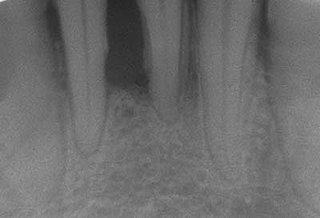
Periodontal disease, also known as gum disease, is a set of inflammatory conditions affecting the tissues surrounding the teeth. In its early stage, called gingivitis, the gums become swollen and red and may bleed. It is considered the main cause of tooth loss for adults worldwide. In its more serious form, called periodontitis, the gums can pull away from the tooth, bone can be lost, and the teeth may loosen or fall out. Halitosis may also occur.

A toothbrush is an oral hygiene tool used to clean the teeth, gums, and tongue. It consists of a head of tightly clustered bristles, atop of which toothpaste can be applied, mounted on a handle which facilitates the cleaning of hard-to-reach areas of the mouth. They should be used in conjunction with something to clean between the teeth where the bristles of the toothbrush cannot reach - for example floss, tape or interdental brushes.
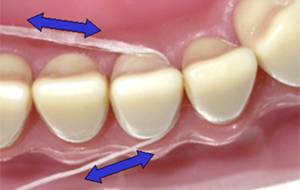
Dental floss is a cord of thin filaments used in interdental cleaning to remove food and dental plaque from between teeth or places a toothbrush has difficulty reaching or is unable to reach. Its regular use as part of oral cleaning is intended to maintain oral health.
An electric toothbrush, motorized toothbrush, or battery-powered toothbrush is a toothbrush that makes rapid automatic bristle motions, either back-and-forth oscillation or rotation-oscillation, in order to clean teeth. Motions at sonic speeds or below are made by a motor. In the case of ultrasonic toothbrushes, ultrasonic motions are produced by a piezoelectric crystal. A modern electric toothbrush is usually powered by a rechargeable battery charged through inductive charging when the brush sits in the charging base between uses.
Periodontology or periodontics is the specialty of dentistry that studies supporting structures of teeth, as well as diseases and conditions that affect them. The supporting tissues are known as the periodontium, which includes the gingiva (gums), alveolar bone, cementum, and the periodontal ligament. A periodontist is a dentist that specializes in the prevention, diagnosis and treatment of periodontal disease and in the placement of dental implants.
Dental plaque is a biofilm of microorganisms that grows on surfaces within the mouth. It is a sticky colorless deposit at first, but when it forms tartar, it is often brown or pale yellow. It is commonly found between the teeth, on the front of teeth, behind teeth, on chewing surfaces, along the gumline (supragingival), or below the gumline cervical margins (subgingival). Dental plaque is also known as microbial plaque, oral biofilm, dental biofilm, dental plaque biofilm or bacterial plaque biofilm. Bacterial plaque is one of the major causes for dental decay and gum disease.
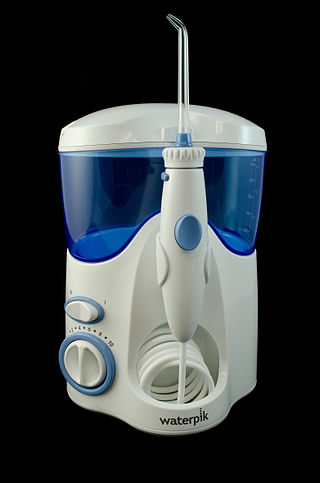
An oral irrigator is a home dental care device which uses a stream of high-pressure pulsating water intended to remove dental plaque and food debris between teeth and below the gum line. Regular use of an oral irrigator is believed to improve gingival health. The devices may also provide easier cleaning for braces and dental implants. However, more research is needed to confirm plaque biofilm removal and effectiveness when used by patients with special oral or systemic health needs.

The gingival sulcus is an area of potential space between a tooth and the surrounding gingival tissue and is lined by sulcular epithelium. The depth of the sulcus is bounded by two entities: apically by the gingival fibers of the connective tissue attachment and coronally by the free gingival margin. A healthy sulcular depth is three millimeters or less, which is readily self-cleansable with a properly used toothbrush or the supplemental use of other oral hygiene aids.
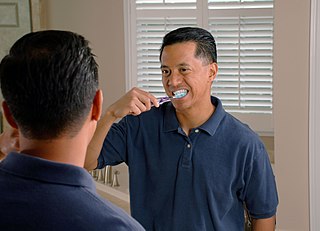
Tooth brushing is the act of scrubbing teeth with a toothbrush equipped with toothpaste. Interdental cleaning can be useful with tooth brushing, and together these two activities are the primary means of cleaning teeth, one of the main aspects of oral hygiene. The recommended amount of time for tooth brushing is two minutes.
Bleeding on probing (BoP) which is also known as bleeding gums or gingival bleeding is a term used by dentists and dental hygienists when referring to bleeding that is induced by gentle manipulation of the tissue at the depth of the gingival sulcus, or interface between the gingiva and a tooth. BoP is a sign of periodontal inflammation and indicates some sort of destruction and erosion to the lining of the sulcus or the ulceration of sulcular epithelium. The blood comes from lamina propria after the ulceration of the lining. BoP seems to be correlated with Periodontal Inflamed Surface Area (PISA).

Scaling and root planing, also known as conventional periodontal therapy, non-surgical periodontal therapy or deep cleaning, is a procedure involving removal of dental plaque and calculus and then smoothing, or planing, of the (exposed) surfaces of the roots, removing cementum or dentine that is impregnated with calculus, toxins, or microorganisms, the agents that cause inflammation. It is a part of non-surgical periodontal therapy. This helps to establish a periodontium that is in remission of periodontal disease. Periodontal scalers and periodontal curettes are some of the tools involved.
Gingivectomy is a dental procedure in which a dentist or oral surgeon cuts away part of the gums in the mouth.
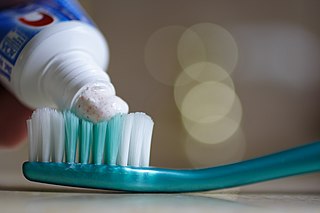
Oral hygiene is the practice of keeping one's oral cavity clean and free of disease and other problems by regular brushing of the teeth and adopting good hygiene habits. It is important that oral hygiene be carried out on a regular basis to enable prevention of dental disease and bad breath. The most common types of dental disease are tooth decay and gum diseases, including gingivitis, and periodontitis.

Gingivitis is a non-destructive disease that causes inflammation of the gums; ulitis is an alternative term. The most common form of gingivitis, and the most common form of periodontal disease overall, is in response to bacterial biofilms that are attached to tooth surfaces, termed plaque-induced gingivitis. Most forms of gingivitis are plaque-induced.
Gingival disease is a term used to group the diseases that affect the gingiva(gums). The most common gingival disease is gingivitis, the earliest stage of gingival-related diseases. Gingival disease encompasses all the conditions that surround the gums, this includes plaque-induced gingivitis, non-dental biofilm plaque-induced gingivitis, and periodontal diseases.

In dentistry, debridement refers to the removal by dental cleaning of accumulations of plaque and calculus (tartar) in order to maintain dental health. Debridement may be performed using ultrasonic instruments, which fracture the calculus, thereby facilitating its removal, as well as hand tools, including periodontal scaler and curettes, or through the use of chemicals such as hydrogen peroxide.
Chronic periodontitis is one of the seven categories of periodontitis as defined by the American Academy of Periodontology 1999 classification system. Chronic periodontitis is a common disease of the oral cavity consisting of chronic inflammation of the periodontal tissues that is caused by the accumulation of profuse amounts of dental plaque. Periodontitis initially begins as gingivitis and can progress onto chronic and subsequent aggressive periodontitis according to the 1999 classification.
Aggressive periodontitis describes a type of periodontal disease and includes two of the seven classifications of periodontitis as defined by the 1999 classification system:
Peri-implant mucositis is defined as an inflammatory lesion of the peri-implant mucosa in the absence of continuing marginal bone loss.